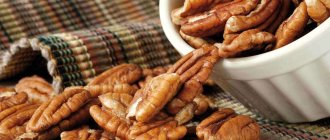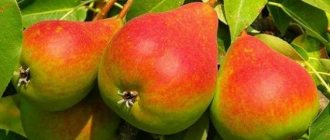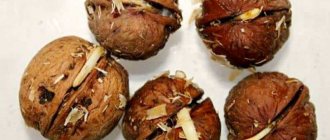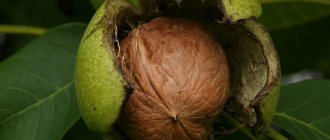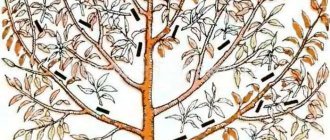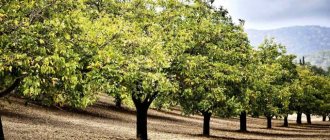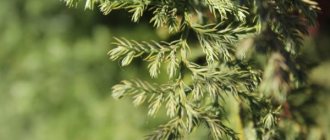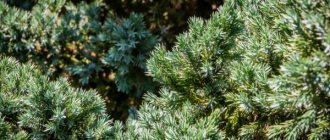Description
The common pecan or hazel belongs to the Nut family. The height of the crop is 15-40 meters, under favorable conditions it reaches 60 meters. The crown is spreading, reaching a girth of 35-40 meters. The trunk is straight, with gray-brown bark and a diameter of 2-2.5 meters. The branches of an adult representative are smooth with abundant green mass. The foliage is dense, glossy, bright emerald.
Hazel blooms in late spring - early summer. In northern latitudes, the flowering period shifts by 20-25 days. The inflorescences of the exotic nut are located in the upper part of the shoots. They are divided into male and female.
Pollination occurs thanks to the wind, so the presence of other trees nearby is necessary.
The fruits are edible oval-shaped nuts with a pointed tip, 7-8 cm long and up to 3 cm wide. The average weight of the fruit is 15-20 grams. The color of mature specimens is coffee brown. The nut kernel has a pleasant sweetish taste and oily structure.
Expert opinion
Yarmishko Vasily Trofimovich
Head of the Department of Botany and Dendrology
Fruiting occurs at 9-11 years of age in September and ends in mid-autumn. The nuts fall off when ripe. The average yield is from 5 kg to 15 kg. Mature crops in southern latitudes produce up to 200 kg of harvest.
The fruiting period of a healthy tree is 300 years.
Nuts are rich in microelements, amino acids, and tannins. Pecans are useful for anemia, heart and vascular diseases, and are used in cooking.
Growing conditions
The common pecan is a heat- and moisture-loving plant, so countries with a warm climate are most favorable for its growth. However, thanks to the work of breeders, today it is possible to grow varieties adapted to the climate of the middle zone. And some plant species tolerate prolonged frosts down to -40˚C well.
The culture is propagated by seeds, cuttings or grafting. When breeding at home, the first method is the most common.
In order for the tree to produce good harvests, the following rules must be followed:
- Nuts are sown in the ground to a depth of about 7 cm, and then covered with a layer of mulch, which prevents the rapid evaporation of moisture from the soil.
- It is recommended to plant at least trees in one area. This is necessary for high-quality pollination and obtaining a large number of ovaries. It should be taken into account that mature trees are impressive in size, so you should allocate enough space for planting seedlings.
- Pecans love open sunny places. It does not grow well near tall buildings and large numbers of other trees.
- After planting young seedlings, it is necessary to provide them with regular watering. At the same time, excess moisture can lead to rotting of the roots. To avoid this, it is recommended to plant trees in loose soil in places where there is no high groundwater. You also need to take into account that kariya does not tolerate too acidic and salty soil.
Until young trees reach 2-3 years of age, you need to trim the crown 2-3 times. This is necessary for the formation of a powerful skeleton. Mature trees do not need to be pruned if they do not have frozen shoots or broken branches.
Over the course of a year, the sprout emerging from the seed reaches a height of about 30 cm. To prevent it from being clogged by weeds, it is necessary to regularly weed the areas around the trees. This will also improve access to the sun to the above-ground parts and oxygen to the roots. After 2-3 years, the tree grows to 50 cm.
Tip: When propagating by grafting, experienced gardeners recommend using a white pecan variety as a rootstock. Growing using this method allows you to get the first harvest already in the 4-5th year of the tree’s life.
Thanks to the strong and sealed shell, nut kernels are very rarely damaged by various insects. However, with prolonged high humidity, fungal diseases can appear in the bark of trees. Fungicides are used to prevent and control them.
Where does it grow
North America is considered the birthplace of the nut. It is cultivated on an industrial scale in the USA, Canada and Central Asia. In Russia, heat-loving brown hazel is found on the Black Sea coast and in Crimea. Successful cultivation is also possible in the middle zone: in the Moscow region, Vladimir and Nizhny Novgorod regions.
Winter-hardy varieties grow both in the shade and in lighted areas. They are demanding in terms of soil composition, groundwater depth and agricultural technology. Young seedlings are cultivated in greenhouses and at home, regulating microclimate parameters (temperature, humidity).
Growing process
Components for growing are prepared in late autumn. Then, in warm climates, they can be planted in the garden. When planting in the middle zone, it is recommended to first germinate the seeds using the greenhouse method. The strongest seedlings are brought into the soil.
If planting occurs in the fall, then it is necessary to prepare beds with furrows. The seeds are deepened by approximately 6 cm. When the seedlings emerge, they are thinned out. The strongest plants remain.
The seedling method of growing pecans from seeds is quite simple:
- The seeds should be placed in damp sand in December and stored in the refrigerator or cellar.
- At the beginning of March, it is necessary to fill the prepared material with warm water and leave for three days. The temperature should be room temperature.
- After this, the seeds are poured into a container and kept warm. Planting material is very demanding to care for, so it should be washed with water every day. You also need to pay attention so that mold does not appear on the seeds.
- After the sprouts appear, they are transplanted into a container with soil.
Seedlings need daily watering. During the first year, the plant develops a root. In autumn, the plants are transplanted into open ground.
Popular varieties for the middle zone
For breeding in the Moscow region, Belarus or regions of central Russia, winter-hardy varieties acclimatized to temperate latitudes are suitable. Among them it is worth highlighting:
- “Major” is a type of pecan distinguished by its piquant taste and frost resistance (down to -36°C).
- “Stuart” is a variety with large fruits and strong immunity.
- "Indiana" is the oldest species with a history of 180 years and a slight aftertaste of chestnut.
- "Busseron" is a French hybrid, characterized by ease of care and productivity.
All hazel varieties are frost-resistant, with good yields and excellent tasting qualities of the nuts.
Most pecan varieties were bred in Canada, whose climate is similar to Russian and Belarusian weather conditions.
Difference between pecans and walnuts
These two plants have a lot in common, and at first glance it may even seem that they are identical, but this is not entirely true. Walnuts are not as capricious as pecans and do not require constant care and careful attention after planting.
Despite their external similarity, the fruits of these plants have different tastes; pecans are much sweeter and more delicate in texture, and for this they are highly valued in cooking.
Walnut and pecan fruits (from left to right)
They are also famous for their richer content of nutrients. Pecans have an almost perfect shape, look very neat and have no veins, and they also have a softer skin. The difference in price for these fruits is also noticeable; walnuts are 3-4 times cheaper than their overseas relative.
Seedlings or seeds
Reproduction and planting of the crop occurs through grafting, seeds and seedlings. The last 2 methods are used most often.
Seed planting is more cost-effective, but it also requires more time for preparation and growth. The material is pre-soaked for 48 hours, then placed in a container with wet sawdust and stored for 40-60 days in a cool, dark room. As the sawdust dries, it becomes moisturized. Before planting, the seeds are again placed in warm water (30°) for 2 days. Non-viable seed material floats to the surface, while good quality seeds remain at the bottom.
Planting is done in late spring or early autumn in specially prepared soil. Autumn planting is accompanied by mulching and insulation for the winter. The first harvest from seed planting should not be expected earlier than after 10 years.
Important! For planting seeds, nuts that have fallen on their own are used, without external factors (wind, manual collection).
Seedlings are a more convenient option. A pecan harvest planted in this way can be obtained already in the 7th year of the tree’s life. Seedlings do not require any preparatory work. The main thing is to make sure of the quality of the planting material, and for this, young shoots must be carefully examined for damage, signs of disease and development of the root system.
How to grow pecans?
Many people think that exotic pecans are very difficult to grow in the garden. But it is not so. The plant requires more careful care only in the first years after planting, but then it adapts well and produces a rich harvest even in regions with cold winters.
It gained its popularity among gardeners due to its unpretentiousness. It has strong and deep taproots and well-developed lateral roots. It is used for urban landscaping because it has a beautiful crown, retains foliage for a long time, and is drought-resistant.
How a pecan nut grows: photo of a young tree
An adult tree is not picky about soil; it grows well in well-drained, fertile soils, but will also grow in sand and loamy areas. Can tolerate temporary flooding and high groundwater. But in order to get such a stable, healthy tree, you need to pay special attention to it at first. We share advice from experienced gardeners. And the first thing you need to do is choose the right variety.
Pecan varieties for the middle climate zone
Today, more than 150 varieties of pecans are known. Northern varieties do not produce very large nuts, but have good frost resistance, a short growing season, drought resistance and early fruiting.
In many regions of Russia, as well as Belarus and Ukraine, winter-hardy varieties are cultivated. They are well acclimatized and produce rich harvests in temperate latitudes. These include:
- "Kanza" is the most frost-resistant variety;
- "Stuart" - grows in the Southeast of the United States and is a kind of standard for fruit size. It is very large, as for winter-hardy varieties - up to 4.5 cm. It has a pleasant sweetish taste;
- “Major” – has a very pleasant delicate taste;
- “Indiana” - considered one of the most ancient, has an aftertaste of roasted chestnut or chocolate;
- "Carlson 3" is a Canadian early variety with very good small nuts;
- "Busseron" is a hybrid variety that grows well in cool, damp climates.
Pecan varieties bred in Canada are also suitable for most regions of Russia.
Features of cultivation
Pecan is a heat-loving plant, so you need to select the brightest and warmest place in the area for planting it. It is advisable that this is not a hill where there are winds and drafts. In the first 3 years, it is necessary to cover it from the cold for the winter.
Pecans can be planted from seeds and seedlings. Gardeners say that trees grown from seeds show maximum frost resistance and productivity.
Planting pecan seeds in the ground
Pecans: Growing from Seeds
This is the most cost-effective method, but it requires a lot of effort and time for the tree to grow. In order to germinate pecan seeds, they take nuts that have necessarily fallen on their own without additional factors (wind, people). They are soaked in clean water for two days and then placed in damp sawdust or sand. In such a humid environment, the seeds should spend about 40-60 days in a cool, dark place.
Before planting, the nuts must again be placed in water (preferably warm, about 30 degrees) for 2 days. Seeds are planted in late spring or early autumn. You need to plant about 10-15 nuts at once, since not all will sprout. Developed strong seedlings with a height of 20-30 cm are transplanted to a permanent place at one year of age. Small or weak plants are left in a container for up to 2 years.
Loading …
Features of growing from seedlings
This is a more convenient and popular method that gives quick fruiting. In this case, no special preparatory work is required: it is enough to buy a healthy seedling and you can immediately plant it in a permanent place of growth. To get a good future harvest, you should plant 2 plants at once at a distance of 15 cm from each other.
Pecan seedlings
Landing
Pecan places special demands on the “future home.” They include the structure and composition of the soil, the degree of illumination and the absence of drafts.
Site requirements
Caria loves sunlit areas, but moderate partial shade is also acceptable. The soil should be loose, light, fertile. Wet clay and salty soils are not suitable for the crop.
Expert opinion
Yarmishko Vasily Trofimovich
Head of the Department of Botany and Dendrology
The permissible depth of groundwater is at least 2 meters from the surface. Before planting, it is necessary to add mineral fertilizer complexes and humus or compost. If the acidity of the soil is increased, liming is carried out.
To obtain a harvest, you need to plant at least 2 seedlings at a distance of 10 -15 meters from each other.
Landing algorithm
Sequence of actions when planting young seedlings:
- Dig a planting hole 0.5 meters deep and 0.6 meters in diameter.
- Place drainage material (broken bricks, pebbles) on the bottom.
- Mix the excavated soil with humus and mineral fertilizers (if the soil has not been fertilized beforehand).
- Fill the hole one-third full with soil, forming a small mound.
- Place the seedling on it, carefully straightening the roots, and fill the hole with soil.
- Compact the soil in the tree trunk circle.
- Place a support and tie it up.
- Water the seedling generously and mulch the soil.
Humus, straw or sawdust are used as mulch.
Remember! The pecan root system is fragile and even slight damage to the roots can cause the tree to die.
The first watering is carried out with settled water at room temperature. Too cold moisture can “cause shock” in a young plant.
Complete landing instructions
Planting pattern 10x10 meters (minimum 8x8). For cross-pollination, trees should be no more than 50 meters apart.
Preparation of planting holes
- Dig a hole that will be 1.5-2 times the size of the container. The width and depth of the pit is approximately 60-70 cm.
- If the soil is sandy, it is advisable to lay a small layer (up to 15 cm) of clay soil on the bottom. Moisten well, level and compact.
- Then vermicompost, compost or other organic matter is placed on the bottom. If the soil is acidic, you need to add lime.
Landing
- Lower the seedling into the hole, cover it with soil and a soil mixture with sawdust. Compact well so that there is no air left in the ground.
- Make sure that when planting, the root collar of the tree is at ground level no higher than 5-10 cm.
- When planting, it is also necessary to add 8-10 liters of soil mixture with sawdust to the root zone. This will improve the survival rate and strengthen the immunity of the young tree.
- After planting, form a tree trunk circle. Water the seedling with about 4-5 buckets of water and mulch with compost, old sawdust, leaves or a 10 cm layer of straw. This will help retain moisture and reduce the number of weeds. For the same purpose, it is recommended to plant herbs, white clover or flowers near the trunk. They will attract beneficial insects but repel pests.
Rules of care
- After planting in the first 3 years, the trees need to be covered with agrofibre or spruce branches for the winter. Mature trees can tolerate frosts down to -30 degrees.
- It is advisable to water with settled, not cold water. Too cold water suppresses the tree's immunity.
- The amount of watering is determined by the climate and weather. In drier regions, water more frequently and more abundantly.
- Long-term stagnation of water is also dangerous. If groundwater is less than 2 meters away, it is advisable to prepare a drainage layer before planting.
In order for the young tree to overwinter better, it is wrapped in agrofibre or spruce branches. This will protect the plant from excess moisture and severe frosts.
Pecan nut: how it grows photo
Top dressing
And although pecan itself is not a very fastidious tree, regular feeding will allow you to get a good harvest faster. Pecan trees need to be fertilized in spring and fall. Around the end of March, nitrogen fertilizers are applied: you can use saltpeter or mullein. They help the tree grow green mass and shoots. But before winter, you need to apply potassium phosphate fertilizers, which will stimulate the future planting of a good harvest.
Tree and crown formation
Like many garden trees, pecans need to be pruned. It is best to do pruning and crown formation in the spring. It is recommended to cut off all shoots of young seedlings. But the branches on which inflorescences are already forming cannot be touched.
Adult and mature trees undergo sanitary and health-improving pruning. To do this, only old, diseased or damaged branches are removed. If a branch grows incorrectly or crookedly, it is also better to remove it. To protect against pests before the onset of the first cold weather, pecans are also whitened.
Agricultural technology
The agricultural techniques used in cultivating carias do not differ from the agricultural techniques of other nut and fruit trees. However, a competent approach accelerates the adaptation of the seedling and affects future productivity.
Watering
Watering is especially important for the crop in the first 3 years of life. At an older age, the tree easily tolerates short-term drought. Regular moistening affects the yield, size and taste of the nut. The taste becomes sweeter and richer.
When watering, the main thing is to avoid stagnation of water, which negatively affects the root system of the tree and can cause rotting of thin lateral roots. This function is successfully accomplished by the drainage layer laid during planting.
The watering regime changes depending on weather conditions and climate. During the hot summer period, the tree is watered more often and more abundantly. In late autumn, the last water-charging irrigation is carried out.
Top dressing
Fertilizers are applied in spring and autumn. At the end of March, pecans are fed with nitrogen fertilizers: urea (saltpeter) or mullein. Fertilizers of this type stimulate the growth of shoots and the growth of green mass. It is for this reason that they should not be introduced before winter.
At the end of spring, during the period of bud formation, caria is fed with a mixture of potassium salt and superphosphate - 35 g. substances per 10 liters of water.
In autumn, young growth requires fertilization with potassium-phosphorus complexes. This type of fertilizing accelerates the ripening of wood and has a positive effect on the formation of next year’s crop.
Properly carried out fertilizing will allow you to harvest the first harvest 5-6 years after planting.
Formation
Tree pruning or shaping is carried out once a year, most often in spring or autumn. The procedure is formative or sanitary in nature. In the first case, pruning is carried out among young seedlings, from which the shoots are completely removed. This allows you to form the correct healthy crown. The branches on which the inflorescences form are not touched.
Mature trees undergo anti-aging or sanitary pruning. Remove old, damaged, frozen and diseased branches. The same fate befalls incorrectly growing branches.
Planting and caring for pecans
When growing common pecans, it is important to choose the right location. Plants are provided with care throughout the season. In autumn, the nut is prepared for wintering.
Preparation of planting material and site
Typically, gardeners buy seedlings or grafted pecan seedlings. When choosing a plant, it is assessed visually. Choose a specimen without mold, cracks or other damage. The work is carried out in spring or autumn, when the sap flow of the trees slows down.
To obtain a high yield, it is recommended to plant at least two types of this nut. For cross-pollination, 8-10 m are left between seedlings. It is possible to graft different varieties onto one rootstock.
Important! Common pecan prefers sunny areas. Possible planting in partial shade.
Walnut is undemanding to the composition of the soil. The main condition is to avoid wetlands. It grows best in fertile, loose soils. Before planting, the beds are dug up, humus and mineral fertilizers are added.
Landing rules
Pecan planting procedure:
- First, dig a hole 50 cm deep and 60 cm in diameter.
- Fertile soil is prepared to fill it. Humus and mineral fertilizers can be added to the soil.
- The hole is filled with earth and a support is installed, then a small hill is formed.
- A seedling is placed on top, its roots are covered with soil and compacted.
- The plant is tied to a support.
Watering and fertilizing
The soil in the tree trunk circle is regularly moistened. Watering is especially important for young seedlings. At the same time, moisture stagnation is not allowed, which leads to the death of the tree.
Common pecan responds positively to fertilizing. In the spring, mullein or urea solution is added. When the ovaries are formed, the nut is fertilized with potassium salt and superphosphate. The consumption of each substance per 10 liters of water is 35 g.
Trimming and shaping
Every year, weak, dry and frozen shoots are pruned from common pecans. Treatment is carried out in spring or autumn. For young plantings, formative pruning is performed. The shoots are removed completely. The branches are not shortened, since inflorescences form on them.
Preparing for winter
Most varieties of common pecan are highly winter hardy. Insulation is required for young seedlings. Their trunk is wrapped in agrofibre to protect against frost and rodents. In late autumn, the nut is watered abundantly. Then the trunk is hilled up and a layer of humus mulch is poured.
Pests and diseases
Despite the exotic origin of the crop, it has strong immunity and is rarely attacked by insects and pests. The most common problem with this representative of the Nut family is the appearance of fungal colonies on the surface of the bark. This type of mold multiplies during a long absence of sun and a long period of dampness.
They fight the “disease” in different ways: from chemicals to folk remedies.
The following is used as “chemistry”:
- solution of copper or iron sulfate (5%);
- a mixture of water and caustic soda (100 g per 12 liters of water);
- Bordeaux mixture;
- fungicides (Topaz, Forecast).
Adherents of organic farming prefer safe natural remedies:
- baking soda;
- apple cider vinegar solution;
- ammonia solution.
The best way to get rid of the disease is its prevention. To do this, they regularly trim, fertilize and whitewash the trunks before the onset of the first frost.
Botanical description
This plant belongs to the genus Hickory and the Walnut family. Its maximum height is 60 m. The tree has a wide spreading crown, the diameter of which reaches 40 m. Its trunk is smooth, covered with gray-brown bark.
Pecan flowers can be male or female, and pollination occurs with the help of wind and insects. The flowering period occurs in May - June, but can shift depending on climatic conditions and in the northern regions begin in June and end in July.
Wintering
The varieties used in the Moscow region and Belarus are characterized by high winter hardiness and can withstand temperatures down to -35°C. However, in the first years of life they need protection, not only from frost, but also from rodents who are not averse to feasting on young wood.
At the end of autumn, seedlings are shed, mulched with humus or compost and covered with agrofibre. The material is tightly fixed to the tree trunk.
The young tree is covered with spruce branches or a special covering fabric for the winter. This is necessary not only to protect the seedling from frost, but also from heavy rainfall that may occur in autumn or spring.
Pruning and preparation for winter
Dry and frozen shoots should be pruned every year. Treatment is carried out once a year. The right time for this procedure is spring or autumn.
Formative pruning should be performed on young seedlings. The shoots are completely removed. The branches cannot be shortened, as inflorescences form on them. Therefore, this procedure should be taken responsibly so as not to harm the plant.
Despite the fact that many varieties of this tree are distinguished by their winter hardiness, insulation is still necessary for young seedlings. The tree trunk should be wrapped in agrofibre. It will help protect against rodents and frost.
At the end of autumn, the tree should be watered abundantly, then a layer of humus mulch should be added.
Harvest storage
Fruits that fall to the ground on their own are considered ripe. The harvest must be collected immediately, otherwise it will easily become prey for birds and animals that are not averse to feasting on North American exotics.
Once collected, the nuts are laid out in the fresh air for 7-10 days, allowing them to dry thoroughly. After this, they are cleaned and stored in closed containers for up to 6 months, or they are sent uncleaned to the freezer, where they remain without losing their beneficial properties for up to 2 years.
The benefits and harms of pecan nuts for the body
Beneficial properties Pecan has a positive effect on the nervous system. Improves brain function and emotional state, reduces the risk of depression.
Helps strengthen the cardiovascular system. Reduces cholesterol levels and the risk of cholesterol plaques, normalizes blood pressure, reduces the risk of heart attack and stroke.
Useful for the gastrointestinal tract. Helps restore the disturbed balance of intestinal microflora in diseases such as dysbiosis and intestinal disorders. Improves metabolic and metabolic processes. Strengthens the gastric mucosa, helps with gastritis and colitis. Prevents the occurrence of constipation and hemorrhoids.
Nuts help with muscle and joint pain. Helps strengthen bones thanks to calcium in the composition.
Increases immunity, indicated for vitamin deficiency.
Helps improve vision and is a preventative against cataracts and glaucoma.
Useful in the treatment of upper respiratory tract diseases.
They help with inflammatory processes and also have wound healing and antibacterial properties.
Helps strengthen nails and hair, improve skin quality.
Harmful properties and contraindications Pecan nuts are contraindicated in the presence of allergies and individual intolerances, also for children under three years of age.
If the norm is exceeded, which is 20-25 g, the heart, liver and gastrointestinal tract can be overloaded.
Use with caution for people with diseases of the gastrointestinal tract, pancreas and liver, as well as metabolic disorders.
Features of pecan cultivation in the middle zone
Growing pecans in temperate latitudes has a number of characteristic features that need to be remembered when cultivating this exotic crop:
- For use in the middle zone, only frost-resistant varieties are suitable.
- A sufficient amount of sunlight and proper watering will increase the yield of caria and allow it to adapt faster.
- Nitrogen fertilizing aimed at growth is applied only in the spring.
The specific climate of the Moscow region does not always allow for a full harvest, so summer residents often plant a more “distant relative” of the pecan – heart-shaped hazel. This species is used more often for decorative purposes, as its fruits have a bitter taste.
Features of growing pecans in the Moscow region
To grow northern pecan nuts in the Moscow region, it is important to take into account a number of nuances:
- select a winter-hardy grafted variety;
- when growing from seeds, they must be stratified;
- allocate an open sunny place for the tree;
- Nitrogen fertilizers are applied only in the spring; be sure to feed the tree in summer and late autumn.
Pecans are not susceptible to spring frosts due to their early flowering. However, it is recommended to carefully prepare trees for winter, especially young plantings.
In the conditions of the Moscow region, pecans do not always have time to produce a harvest over the summer. An alternative planting option is heart-shaped hazel. It is a wild relative of the pecan and can withstand winter cold without any problems. Its fruits have a bitter taste.
How to choose when purchasing and store pecans?
When buying nuts from this tree, you need to monitor the condition of its kernel - it should be whole and fleshy. If you purchase nuts in shell, it is better to choose ones that are clean and free of any damage. At the same time, according to their size, they should be heavy. To keep nuts in good condition longer, it is recommended to keep them in an airtight container in the refrigerator or freezer. Pecans will last about 4 months in the refrigerator, and up to six months in the freezer. Before eating nuts, they need to be heated at room conditions to 20-23⁰C.
Reproduction methods and planting rules
As a mountain relative, pecan survives well in a variety of conditions. This tree can be propagated in several ways:
- grafting onto a related variety (for example, white Pecan);
- budding;
- cuttings;
- seed propagation.
In the latter case, ripe fruits are planted, which have separated from their peel without the help of natural forces (wind) or human intervention. The color of this nut is brown or chocolate, the surface does not contain any traces of rotting or darkening. The fruits are planted in previously prepared furrows, their depth is 10 cm. The nut is placed in the furrow and sprinkled with soil on top.
Planting scheme: 10 to 15 seedlings are placed per 1 m of soil. It is recommended to make furrows at a distance of at least 1 meter from each other. This will harden the seedlings in winter and ensure natural stratification.
Spring planting of seedlings takes place no earlier than April. The spring planting procedure is more labor-intensive and requires preparatory work:
- Carry out artificial stratification.
- Soak the planting material in a container with water for 2–3 days.
- Place seedlings soaked in water in moistened peat or sawdust. The wood must be fresh.
- Move the planting material to the balcony or cellar.
- Control the soil substrate: maintain constant humidity and temperature conditions up to 4 °C.
- Keep the seedlings in a cold room for 8 weeks.
Planting material is planted according to the same pattern as in the fall. The basic rule is the correct selection of a site for growing a tree. The place should be well lit and provide the young tree with protection from strong winds.
When choosing a place to plant this nut, it is important that there is no stagnation of water in the area. Otherwise, the plant may die from rotting of the root system before rooting is completed.
Sprouted pecan
In the first years of life, trees of this species are characterized by slow growth. In three years, a seedling can only reach 35 cm in height. Therefore, it is advised to replant the pecan to a permanent place of residence when the tree is 4 years old.
To plant in a permanent place, a hole measuring 60x60 cm is dug in the soil. Pecans do not take soil with a high level of acidity very well, so lime is used to neutralize the environment. Rotted compost is used as fertilizer.
Its use makes it possible to make the soil more fertile and nutritious.
Before placing it in the soil, all remaining soil is removed from the roots, the rhizomes are carefully leveled, and sprinkled with soil on top. The soil around the trunk of the seedling is compacted to prevent the appearance of hollow holes in which moisture can stagnate. A mandatory measure is moderate watering of the seedling.
Before planting a pecan seedling, the roots should be cleared of soil.
Fertilizing is carried out in autumn and spring. At the beginning of the year, nitrogen fertilizers are used, which act as a shoot growth stimulator. In the autumn season, phosphorus and potassium are used as fertilizing.
Older trees also need feeding. The materials used are superphosphate, urea, saltpeter, and potassium salt. Feeding old nuts is carried out during the autumn season.
When growing pecans in a garden plot, another measure to care for the plant is spring rejuvenating and sanitary pruning. Branches that grow improperly, are broken, or are infested with pests must be removed.
Relatives from Georgia brought unusual nuts as a gift to a friend. I accidentally saw them in his car and asked him to give me a few to breed. Since we live in the south, in the Krasnodar region, I thought that perhaps our climate would also be suitable for growing this interesting crop.
Pecan or mystery crop
For a long time I could not even find out the name of the plant whose nuts I got. Outwardly, they are similar to walnuts, but more elongated and slightly pointed at the ends. The shell is smooth, thin, there are no partitions inside. The kernels look like walnuts, but the folds on them are not so sinuous.
The taste is more tender and sweeter. Having reviewed more than one reference book and key, I realized that this is the common pecan (or Illinois Caria
). The culture is capable of bearing fruit for 300-400 years! Belongs to the hickory genus of the nut family. It is a spreading deciduous tree up to 60 m in height. Their leaves are like those of rowan, but larger - up to 50 cm in length and without jagged edges.
Pecans are grown commercially in Central Asia and the southeastern United States. In our country, there are small plantings of it in the Caucasus and Crimea.
Pecan nut – 200 kg per tree!
The crop blooms in May-June. Wind pollinated. Male walnut flowers are catkins. The female ones are collected in inflorescences-spikelets - up to 11 pieces. in everyone.
The nuts reach 8 cm in length and 3 cm in width. They weigh up to 20 g. They ripen in September-October. The yield of old trees reaches 200 kg per tree. Young ones produce less fruit. Nut kernels contain a lot of fat and can go rancid if stored for a long time. Pecans are eaten fresh and roasted, and used in cooking and confectionery production.
Anyone who decides to grow these trees should take into account their impressive size. That is, you will have to devote a considerable part of the garden to pecans. Moreover, the crop requires at least 2 trees to bear fruit.
Pre-winter sowing of pecans
Nuts need stratification before sowing. They are soaked for 3 days in water, and then planted in holes with sand before winter. Sprinkle with compost.
But the nuts fell into my hands before the New Year, when there was already snow. So after soaking, I placed them in a pot with damp sawdust and put them in the refrigerator. And in April I planted it at the dacha, deepening it 5-7 cm into the soil. A month later, 5 strong seedlings sprouted. They are now a year old. If you believe the information that I found, seedlings will begin to bear fruit only at the age of 8-11 years.
In the south, pecans are also propagated by budding, grafting onto other varieties of the same crop, and cuttings. And then the trees begin to bear fruit after 4-5 years.
Pre-winter sowing of pecans
Nuts need stratification before sowing. They are soaked for 3 days in water, and then planted in holes with sand before winter. Sprinkle with compost.
But the nuts fell into my hands before the New Year, when there was already snow. So after soaking, I placed them in a pot with damp sawdust and put them in the refrigerator. And in April I planted it at the dacha, deepening it 5-7 cm into the soil. A month later, 5 strong seedlings sprouted. They are now a year old. If you believe the information that I found, seedlings will begin to bear fruit only at the age of 8-11 years.
Read also: Cruciferous flea beetle: the most effective methods of control
In the south, pecans are also propagated by budding, grafting onto other varieties of the same crop, and cuttings. And then the trees begin to bear fruit after 4-5 years.
Characteristics of pecans
Biologists classify the common pecan as one of those tree species that have the property of rapid growth, but it is not activated immediately. In its natural environment, this species grows up to 60 meters. In hot climates, the tree reaches 40 meters in a short time. In colder regions its height does not exceed 10–15 meters.
During the first three years, young pecans gain strength, and the root system grows to the level at which it has access to water, so the tree itself grows to 40–45 cm. Garden pecan grows with a straight trunk, from which strong branches extend. Even without pruning, the crown of the tree grows well-shaped - slightly elongated, ovoid or spherical.
The pecan tree grows with bark colored gray. The bark of old trees cracks and streaks of gray-brown color appear on it.
The foliage of the pecan tree is rich green. The leaves consist of feathers, the number of which ranges from 11 to 17 pieces. Each feather is elongated and pointed towards the end. The leaf dimensions are on average 9–12 cm in length and 2.5–7 cm in width.
The formation of the fruits of the tree occurs in October. The nuts have an elliptical shape, a matte shell, and a pointed end. The central part of the fruit produced by the American black walnut, when cracked, springs out of the red-brown shell that holds and surrounds the core. The inside of the nut consists of two identical cotyledons. In this respect, Brazil nuts are similar to walnuts. In tropical areas, the fruits of this tree can become food for toucans. The harvest is harvested in November, but there are varieties that ripen fruit earlier.
The pecan tree grows up to 60 meters in height
In a greenhouse or in a room?
The culture grows in both sun and partial shade. Loves fertile, loose, well-drained soil. Withstands short-term temperature drops in winter down to -30C. It is responsive to abundant watering, although it also tolerates drought.
Around young trees it is necessary to pull out weeds, fertilize, loosen and mulch the soil. Seedlings can be transplanted to a permanent place from the age of one year. At first they do not grow quickly - 20-30 cm per year. Then their growth accelerates.
You can also grow pecans indoors, in a greenhouse, or in a greenhouse. Only in dry indoor air do trees need to be sprayed regularly. And in winter (from November to March) keep the plants in a cool room at a temperature of 8-12°. During the dormant period, do not fertilize them and reduce watering.
Personally, I plan to sell 3 of my seedlings and plant 2 in front of the country house. When they grow up, they will shade the yard in the summer heat.
If I am lucky enough to find pecan seedlings at nurseries, I will buy 2 more to plant behind the house so that cross-pollination occurs with my seedlings. If only I didn’t get seedlings of the same variety as mine. Although this is unlikely, because more than 150 varieties of pecan nut have been bred. Among them, as I found out, the following are considered the most suitable for the Russian climate: Major, Textam, Green River, and Indiana. Stewart and Success
.
Pecan nut – 200 kg per tree!
The crop blooms in May-June. Wind pollinated. Male walnut flowers are catkins. The female ones are collected in inflorescences-spikelets - up to 11 pieces. in everyone.
The nuts reach 8 cm in length and 3 cm in width. They weigh up to 20 g. They ripen in September-October. The yield of old trees reaches 200 kg per tree. Young ones produce less fruit. Nut kernels contain a lot of fat and can go rancid if stored for a long time. Pecans are eaten fresh and roasted, and used in cooking and confectionery production.
Anyone who decides to grow these trees should take into account their impressive size. That is, you will have to devote a considerable part of the garden to pecans. Moreover, the crop requires at least 2 trees to bear fruit.
Fertilizing and feeding pecans
In the spring, it is imperative to fertilize the tree with nitrogen-containing preparations, which stimulate the growth of young shoots. At the beginning of autumn, it is worth applying fertilizers containing phosphorus and potassium in order to stimulate the ripening of wood and the laying of a good, abundant harvest in the future. Young trees are fed in this way, while adult plants are fertilized in the fall with potassium salt, superphosphate and urea.
If you provide the tree with proper care and plant it correctly, it will produce harvests within five years.
